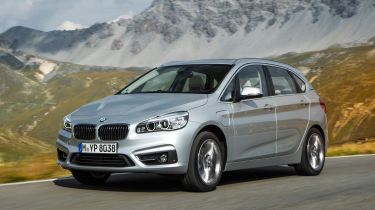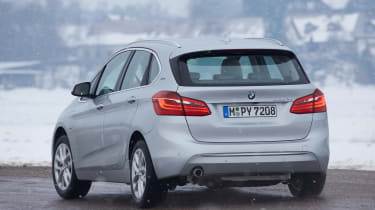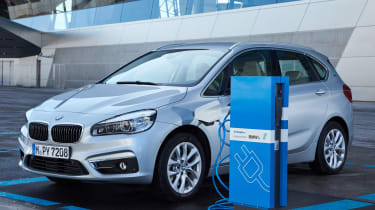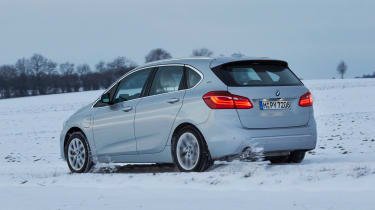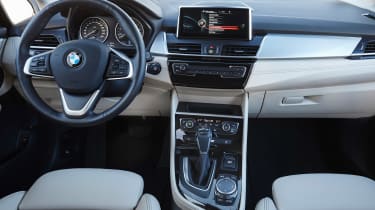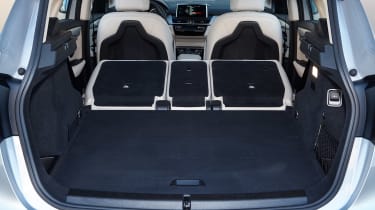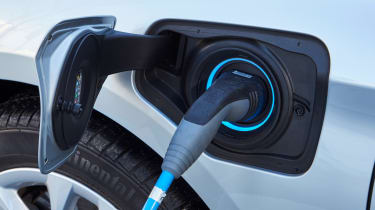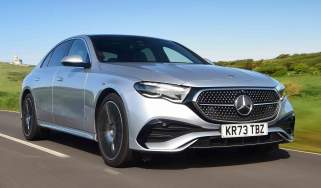BMW 225xe iPerformance hybrid review
“The BMW 225xe iPerformance Active Tourer is a pioneering plug-in hybrid MPV with low running costs and a luxurious interior”
Pros
- 25-mile electric range
- Low running costs
- Luxurious interior
Cons
- No seven-seat version
- Vague steering feel
- Can get expensive
The BMW 225xe iPerformance Active Tourer is the first plug-in hybrid MPV to hit the market, adding a string to the model’s bow that competitors like the Mercedes B-Class can’t currently match.
Under the bodywork – which is only distinguishable from the standard model by badges and a charging flap on the front wing – there’s a 1.5-litre three-cylinder petrol engine, electric motor and battery pack. The technology might sound familiar, because the Active Tourer benefits from a reworked version of the system developed for the BMW i8 supercar.
Here, it produces a combined total of 221bhp, getting the 225xe from 0-62mph in as little as 6.7 seconds. More importantly, this MPV can return 141.2mpg with CO2 emissions of 57g/km, numbers that make it one of the cheapest people carriers to run. Business users will certainly appreciate its 13% Benefit-in-Kind (BiK) liability, but you need to regularly top up the batteries to achieve the above figures.
The driving experience isn’t as involving as traditional BMW models, but a near-silent electric mode allows up to 25 miles of zero-emissions driving, making the iPerformance Active Tourer very relaxing to drive in towns and cities. The light steering pays off here, but feels rather vague on more challenging roads, where the BMW 330e plug-in hybrid is much more involving for keen drivers.
Inside, the 225xe is almost indistinguishable from the standard model, with the choice between Sport, Luxury or M Sport trim levels making the biggest difference to what’s included. BMW has also tried to keep the five-seat MPV as close to the practicality of the petrol and diesel models as possible, positioning the battery pack under the rear seats. While this means the rear passengers sit a little higher up, there’s still plenty of room inside, along with a 400-litre boot.
More reviews
In-depth reviews
BMW customers are a satisfied bunch, with the brand coming ninth out of 27 manufacturers in our 2017 Driver Power owner satisfaction survey. The 2 Series Active Tourer’s five-star Euro NCAP score for crash safety should also provide reassurance for customers.
MPG, running costs & CO2
When fully charged from a mains socket or fast charger, the battery pack can provide around 25 miles of all-electric range, so it’s feasible you could enjoy almost petrol-free motoring if you have a short commute. Official fuel-economy figures come out at 141.2mpg, while CO2 emissions of 57g/km will appeal to company-car drivers thanks to a low 13% BiK liability.
The low tailpipe emissions also mean you can drive into the London Congestion Charge zone for free. After the first year's CO2-based road tax (generally included in the on-the-road price), the 2 Series iPerformance Active Tourer costs £130 a year to tax. Insurance could be pricey, because the 225xe sits in group 23, three groups higher than the petrol 220i and two groups above the top 220d diesel.
As with any plug-in hybrid, driving with the battery on empty will make the 1.5-litre three-cylinder petrol engine work harder, with fuel economy gradually falling as a result. There are several driving modes to choose from, with Max eDrive prioritising all-electric driving, while Auto eDrive allows the car to juggle its power source automatically. There’s also a handy Save Battery mode to keep the battery charge until you want to use it, and lastly a mode that employs the engine as a generator to charge the battery pack.
BMW i Wallbox home fast-chargers are available from around £800, although you can pay more than £2,000 for the i Wallbox Pro with energy management and the ability to connect your own renewable energy supply.
Engines, drive & performance
The 225xe’s engine, electric motor and battery pack have been taken from the BMW i8 sports car, but don’t get too excited – they have been detuned somewhat. Instead of serving up a maximum of 357bhp, the combined output of the 1.5-litre petrol engine and electric motor is 221bhp.
Still, that’s plenty for an MPV, and gets the 2 Series iPerformance from 0-62mph in 6.7 seconds. It’s something of a pioneering model, too, because it’s the first plug-in hybrid MPV on sale. The Toyota Prius+ is a hybrid seven-seat MPV and takes 11.3 seconds to reach the same speed, while a plug-in hybrid SUV like the Mitsubishi Outlander PHEV offers similar passenger space and takes 11 seconds flat.
Most of the time you won’t be trying to sprint off the lights in the 225xe, though. Instead you’ll be using the power of the electric motor to get up to speed quietly and smoothly. It’s possible to drive at up to 78mph on electric power alone, and when the petrol engine does start working, it does so unobtrusively.
It makes for an easy drive around town, but the light steering is vague for a BMW and the 225xe is less fun to drive than the BMW 330e plug-in hybrid, which is based on the BMW 3 Series saloon.
Interior & comfort
For the driver and front-seat passenger, there’s almost nothing to distinguish the plug-in hybrid version of the 2 Series Active Tourer from the regular model. Materials are of the quality you’d expect of a BMW, while the iDrive infotainment system is among the best to operate. The dashboard looks stylish enough, but BMW is bordering on being too traditional compared with some rivals, fitting some switches that will look familiar to owners of much older BMW models.
Passengers in the back have a particularly good view out, helped by the fact their seats have been raised by 30mm to allow the battery pack to be placed underneath. They should be comfortable enough on the move, because the extra weight of the plug-in hybrid technology doesn’t seem to have scuppered ride quality, with most bumps smoothed out effectively.
The 225xe comes in Sport, Luxury or M Sport trim levels, with BMW i badges in place of the M Sport badges that adorn sporty petrol and diesel models. The Sport trim has 17-inch alloy wheels, cloth seats, cruise control, rear parking sensors, an electric tailgate, dual-zone climate control, DAB radio and access to BMW’s eDrive concierge service. All BMW's also come with 'remote services', allowing you to check on your car, set the ventilation, flash the headlights and lock or unlock the doors via a smartphone app. Luxury versions upgrade the wheels to 18 inches and add chrome exterior trim, leather upholstery and an Anthracite headliner. The M Sport version gets a more exuberant body kit and interior highlights like a sports steering wheel and ambient lighting.
Practicality & boot space
By positioning the battery pack under the rear seats, BMW has minimised the reduction in boot space to 68 litres, for a total of 400 litres. That’s just 63 litres smaller than the tall and boxy Outlander PHEV, while the Prius+ is more spacious still, with a 505-litre boot.
Despite hoisting the rear bench up by 30mm, the Active Tourer has a tall enough roof that occupants should still have plenty of headroom, while front passengers will find lots of adjustment for their seats.
The hatchback provides a wide opening for loading in awkward items and comes with electric opening as standard, so you can begin the process from the key fob before even reaching the car.
Reliability & safety
While the BMW 225xe Active Tourer hasn’t been out for long enough to come to a full conclusion on its reliability, the fact a similar setup provides much more power in the i8, leads us to believe it should prove robust here. BMW is spending huge sums engineering plug-in hybrid technology, so it won’t want to get it wrong.
The BMW brand ranked ninth out of 27 manufacturers in our 2017 Driver Power owner satisfaction survey, with 12.4% of owners reporting a fault within the first 12 months. Owners were particularly keen on BMW’s engines, voting them into third place.
While the plug-in hybrid model hasn’t been crash-tested separately by Euro NCAP, the five-star result for the standard car should also cover the 2 Series Active Tourer iPerformance. It’s a reassuring result for families – particularly its impressive 85% score in the child occupant safety category.
See how this car scored on our sister site Driving Electric

